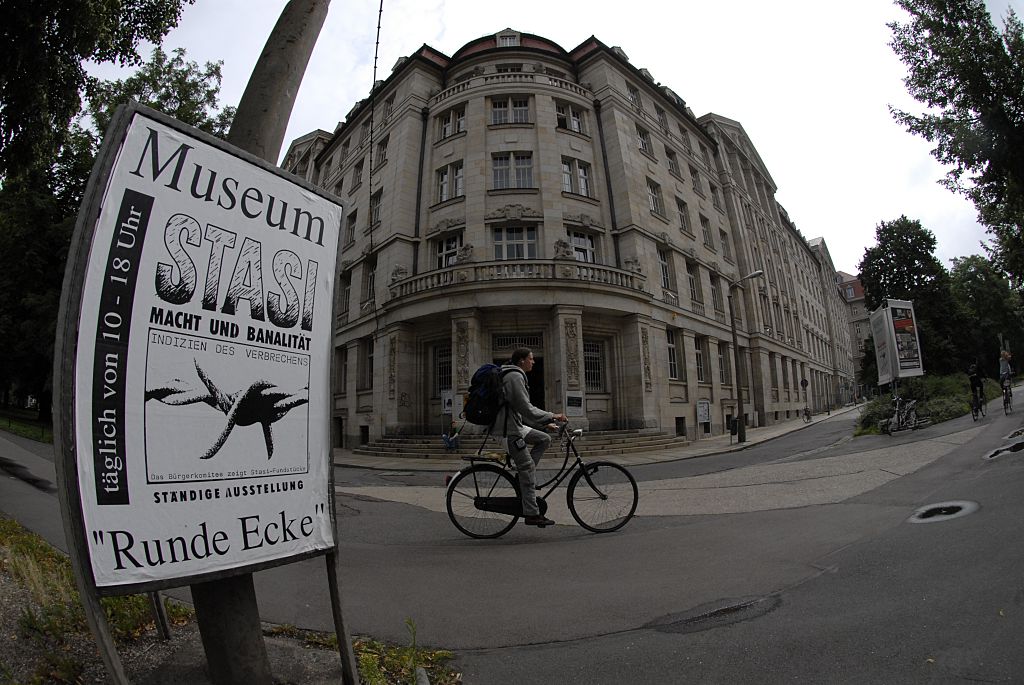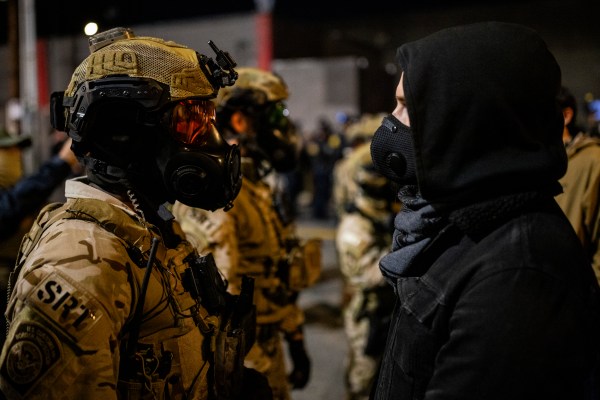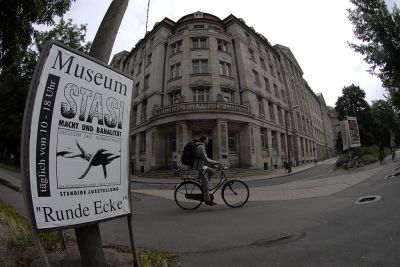LEIPZIG, Germany—At a bend in the ring road that follows the path of what was once the wall around this ancient market city, there squats a hulking gray stone building that looks heavy even by German architectural standards.
The building, known as the Round Corner, “der Runden Ecke” aptly sits midway between the bustling, modern, Euro-vibing main drag and the 15th century St. Thomas’ Church, where Johann Sebastian Bach, who spent the most important part of his career as its music director, is buried. Right between the past and the present.
For Germans middle-aged and older, the Round Corner is a famous place of both horror and hope. Built in the ornate German imperial style for an insurance company at the turn of the previous century, American forces chose the building for their headquarters after the 69th Infantry captured Leipzig this week in April 1945. But a few months later, under the deal struck between the major allied powers that summer in Potsdam, U.S. troops handed over the building, the city and the eastern third of the country to the Soviets.
After Joseph Stalin established the German Democratic Republic four years later, the government chose the building as a headquarters for the new Ministry for State Security, the “Ministerium für Staatssicherheit,” an agency that should forever live in collective memory for the oppressive banality of the terror it imposed: The Stasi.
For the next 40 years, the fortress-like building was a prison, a surveillance post, a torture chamber, and a bureaucratic hive, where hundreds of drones, many in cramped windowless offices, ground out the work of oppression.
For the first couple of decades, the Stasi relied on the kinds of brutality we tend to initially think of in police states: goon squads conducting raids, show trials, and very public acts of authoritarianism. But around 1970, the Stasi moved to what would come to be known as “Zersetzung,” or “decomposition.”
Relying on its astonishing power to surveil—reading every letter in or out of the country, listening to every phone call, equipping a network of spies to infiltrate every church, school, and civic group, and tens of thousands of informants—the Stasi moved from showing the strength of the state to showing the weakness of its enemies. Decomposition was not dissimilar to the methods the Chinese government uses today. Dissidents and potential dissidents were identified and then saw their lives systematically ruined from behind the walls of the Round Corner.
The goal was to “switch off” any person or group that might rally public support for anti-regime sentiments. In the case of individuals, it might include gaslighting—entering their apartments and subtly rearranging or replacing their belongings (e.g. substituting the type of tea or switching their placement of clothes in their drawers), sabotaging their cars, prescribing the wrong medical treatments, derailing their careers, or disrupting travel plans. It included sending falsified compromising documents or photos to spouses, family members, and friends. Victims often ended up breaking down, and in many cases took their own lives.
Decomposition for groups meant sowing mistrust through plots and disinformation and everywhere, always, building a pervasive atmosphere of mistrust. You don’t need to send people to a gulag, if you can, little by little, make every place a gulag.
“Many people succumbed to pressure from the Stasi and other security forces,” writes author Max Hertzberg, “through a process that was commonly called ‘inner migration’: giving up political and social beliefs, following the path of least resistance and ceasing oppositional activity.”
It was an approach that would find admirers and imitation in Moscow and across Soviet satellites from Eastern Europe to Cuba, and still today in the “sincerity scores” imposed by the Chinese Communist Party on its subjects.
But if China is keeping East German-style authoritarianism alive today, it was Chinese authoritarianism that helped bring about the end of East Germany and the fall of the Round Corner gang.
Word of the Chinese regime’s massacre of thousands of student protesters in June 1989 spread quickly in East Germany, where the faltering of its Soviet masters and the breakdown of the centrally planned economy had already created an atmosphere of revolution. Seeing the fate of their Chinese counterparts, East German dissidents decided on massive resistance instead of the more modest showing and aims of the Tiananmen Square protesters.
In Leipzig, the protests centered first on St. Nicholas’ Church on the other side of the old city, and then on the Round Corner. On October 9, an estimated 70,000 protesters marched through the city in the first of what would come to be known as the “Monday Demonstrations.” By the end of the month, there were 500,000 people gathered in the streets of Leipzig. Stasi boss Erich Mielke responded with orders for mass arrests and the establishment of internment camps, but by then, rank-and-file members had more to fear from the mob than their tyrannical leader and ignored the orders. And like many in the 40-year regime, they could stomach no more brutality against their neighbors.
When the Berlin Wall fell on November 9, members of the regime knew their remaining days in power were few. For the Stasi, that represented a serious problem: What to do with the millions of files that very precisely detailed the extent of their crimes against their fellow Germans?
A frantic document destruction project got underway at the Round Corner, with crews working around the clock to shred the files and destroy the surveillance equipment. If you visit the building today, you can see the huge industrial grinders the East Germans brought in to do the job. But on December 4, citizens stormed the building and put a stop to the process, preserving most of what was stored there. Now, 34 years later, any former East German subject may come to the building and read their file, or those of their family members targeted by the Stasi. They can know the truth.
The work of reconciliation has been hard in these past few decades, but it has been made easier by the knowledge among subjects of the former regime that it was their own peaceful revolution, ultimately, that brought down their oppressors. That is how the Round Corner manages to be different from many of the other memorials to human cruelty in this country.
It sits as a tomb of sorts, where the lives destroyed by the old regime are recorded and preserved. But it is also their own version of the Bastille: a place where the people overthrew their oppressors. And unlike France and many scenes of revolution, the country has persisted in the hard work of self government and unification without anarchy or reverting to tyranny.
You can find it all there at the Round Corner, halfway between Germany’s future and past.







Please note that we at The Dispatch hold ourselves, our work, and our commenters to a higher standard than other places on the internet. We welcome comments that foster genuine debate or discussion—including comments critical of us or our work—but responses that include ad hominem attacks on fellow Dispatch members or are intended to stoke fear and anger may be moderated.
With your membership, you only have the ability to comment on The Morning Dispatch articles. Consider upgrading to join the conversation everywhere.